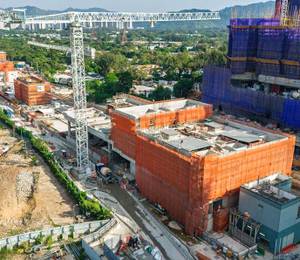The new Tadano AC 5.250-2 is a five-axle all-terrain crane with a maximum capacity of 250 t. It has a main boom length of 70 m, which can be extended by 42 m with a HAV main boom extension, allowing it to reach a system length of 112 m. According to Tadano, all available main boom extensions from 5.8 to 36 m are self-rigging.
The crane features a lifting capacity of 14.5 t with a 70-m boom length at a radius of 12 to 24 m, and lifting capacity of 11 t with a boom length of 47 m at a radius of 42 m.
There are transportation configuration options available for the AC 5.250-2. For instance, the crane can carry a three-sheave hook block for lifting loads of up to 67.3 t or a 5.8-m heavy-lift runner on board while remaining within a 12-t axle load configuration – not to mention that the transportation mounts for the HAV extension are included by default in the 12-t axle load.
Tadano said the AC 5.250-2 can be used as a taxi crane without a support vehicle while remaining within the legal axle load limit of 12 t. And if the axle load is increased to 16.5 t, it can also carry up to 20 t of its maximum counterweight of 80 t.
The AC 5.250-2 can pick up its total counterweight of 80 t in three lifts: 46.6 t with a full 360° radius of up to 6.2 m followed by two lifts of 15.2 t, with each split into 10 and 5.2 t for mounting on the right and left of the base package. If necessary, the counterweight can be split into smaller pieces as well, making it possible, for example, to pick up the 5.5-t base plate from a distance of up to 20.1 m across the full radius.
“Thanks to the IC-1 Plus crane control system, which comes as standard, the available radius can even be significantly increased at certain slewing angles,” said project manager Peter Kleinhans. In addition, given the counterweight can be split into a large number of elements with none weighing more than 10 t, it ensures maximum flexibility for transportation logistics. This means that relatively small trucks can be used for transportation when required by space conditions at a work site.
The IC‑1 Plus crane control system determines the crane’s maximum lifting capacity for every boom position as a function of the superstructure’s slewing angle, and in real time to boot. Thus the crane is always able to take advantage of the maximum lifting capacity available to it – especially during lifts over the outriggers. The outriggers can be extended asymmetrically to 0, 25, 50, 75, and 100% positions.
Using the Surround View camera system, the operators can optimally position the crane at work sites. This system uses six crane cameras to show a computer-assisted diagram of the maximum possible extension lengths for the outriggers at the crane’s current location.
“With Tadano Surround View, crane operators can take a look at a display in the cab to know exactly how they need to position the crane at their work site in order to extend all outriggers sufficiently and ensure that they are using the required counterweight tailswing radius. This eliminates tedious and time-consuming measurements and testing when looking for a location from which to operate the crane, making the latter ready for use faster,” said Mr Kleinhans.
The AC 5.250-2 is powered by a Mercedes-Benz engine with an output of 522 hp and a maximum torque of 2,600 Nm. The HVO-compatible diesel engine meets the latest EU Stage V requirements. It is particularly cost-effective thanks to its eco mode, which ensures that the engine always outputs the exact amount of power that the crane actually needs at any one time, with the IC-1 crane control system taking care of the corresponding calculations.
For operator comfort, all hydraulic components that emit noise are located away from the superstructure cab. The spacious design behind both cabs also delivers maximum operating comfort and a pleasant work environment. To ensure safety, there are intelligently positioned access points, attachment points for operators’ personal safety equipment, and a step that can be extended from the carrier to make it safe and comfortable to enter and exit the superstructure cab.















